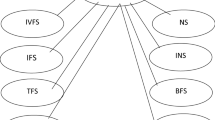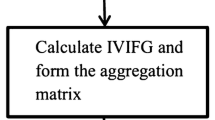Abstract
In this paper, we apply evaluation based on distance from average solution (EDAS) approach to multiple criteria group decision-making (MCGDM) with bipolar fuzzy numbers (BFNs). We reconsider the notion of BFNs and propose its corresponding operational rules, score and accuracy functions. Further, we introduce two aggregation operators and develop an MCGDM approach based on conventional EDAS model with overall BFNs. The proposed technique is valid and accurate for considering the conflicting attributes. We analyse the proposed method by considering a numerical example for the selection of road construction company project to show the effectiveness of the developed approach. At last, we compare the developed systems with some existing operators to deliver its efficiency.
Similar content being viewed by others
References
Abdullah S, Muhammad A, Kifayat U (2014) Bipolar fuzzy soft sets and its applications in decision making problem. J Intell Fuzzy Syst 27(2):729–742
Akram M, Waseem N, Liu P (2019) Novel approach in decision making with m-polar Fuzzy ELECTRE-I. Int J Fuzzy Syst 21:1117–1129
Atanassov KT (2012) On intuitionistic fuzzy sets theory. Studies in fuzziness and soft computing, vol 283. Springer, Berlin
Bielinskas V, Burinskienė M, Podviezko A (2018) Choice of abandoned territories conversion scenario according to MCDA methods. J Civ Eng Manag 24(1):79–92
Brans JP, Mareschal B, Vincke P (1984) PROMETHEE: a new family of outranking methods in MCDM. Brans Oper Res IFORS 84:477–490
Eroglu H, Sahin R (2020) A neutrosophic VIKOR method-based decision-making with an improved distance measure and score function: case study of selection for renewable energy alternatives. Cogn Comput 12:1338–1355
Ecer F (2018) Third-party logistics (3PLS) provider selection via fuzzy AHP and EDAS integrated model. Technol Econ Dev Econ 24:615–634
Feng XQ, Wei CP, Liu Q (2018) EDAS method for extended hesitant fuzzy linguistic multicriteria decision making. Int J Fuzzy Syst 20:2470–2483
Fink G, Yolles M (2015) Collective emotion regulation in an organization—a plural agency with cognition and affect. J Organ Change Manag 28(5):832–871
Ghorabaee MK, Zavadskas EK, Olfat L, Turskis Z (2015) Multi-criteria inventory classification using a new method of evaluation based on distance from average solution (EDAS). Informatica 26:435–451
Ghorabaee MK, Zavadskas EK, Amiri M, Turskis Z (2016) Extended EDAS method for fuzzy multi-criteria decision-making: an application to supplier selection. Int J Comput Commun Control 11:358–371
Ghorabaee MK, Amiri M, Zavadskas EK, Turskis Z, Antucheviciene J (2017a) A new multi-criteria model based on interval type-2 fuzzy sets and EDAS method for supplier evaluation and order allocation with environmental considerations. Comput Ind Eng 112:156–174
Ghorabaee MK, Amiri M, Zavadskas EK, Turskis Z, Antucheviciene J (2017b) Stochastic EDAS method for multi-criteria decision-making with normally distributed data. J Intell Fuzzy Syst 33:1627–1638
Ghorabaee MK, Amiri M, Zavadskas EK, Turskis Z (2017c) Multi-criteria group decision-making using an extended EDAS method with interval type-2 fuzzy sets. E and M Ekon Manag 20:48–68
Ghorabaee MK, Amiri M, Zavadskas EK, Turskis Z, Antucheviciene J (2018a) A comparative analysis of the rank reversal phenomenon in the EDAS and TOPSIS methods. Econ Comput Econ Cybern Stud Res 52:121–134
Ghorabaee MK, Amiri M, Zavadskas EK, Turskis Z, Antucheviciene J (2018b) A dynamic fuzzy approach based on the EDAS method for multi-criteria subcontractor evaluation. Information 9:68
Ghorabaee MK, Amiri M, Zavadskas EK, Antucheviciene J (2018c) A new hybrid fuzzy MCDM approach for evaluation of construction equipment with sustainability considerations. Arch Civ Mech Eng 18(1):32–49
Gomes LFAM, Lima MMPP (1992) TODIM: basics and application to multicriteria ranking of projects with environmental impacts. Found Comput Decis Sci 16:113–127
Gul Z (2015) Some bipolar fuzzy aggregations operators and their applications in multicriteria group decision making. M.Phil Thesis
Han Y, Shi P, Chen S (2015) Bipolar-valued rough fuzzy set and its applications to decision information system. IEEE Trans Fuzzy Syst 23(6):2358–2370
Ilieva G (2018) Group decision analysis algorithms with EDAS for interval fuzzy sets. Cybern Inf Technol 18:51–64
Ibrar M, Khan A, Davvaz B (2017) Characterizations of regular ordered semigroups in terms of \((\alpha, \beta )\)-bipolar fuzzy generalized bi-ideals. J Intell Fuzzy Syst 33:365–376
Ibrar M, Khan A, Khan S, Abbas F (2019) Fuzzy parameterized bipolar fuzzy soft expert set and its application in decision making. Int J Fuzzy Logic Intell Syst 19(4):234–241
Jana C, Pal M (2018) Application of bipolar intuitionistic fuzzy soft sets in decision making problem. Int J Fuzzy Syst Appl 7(3):32–55
Jana C, Pal M, Wang JQ (2019a) A robust aggregation operator for multi-criteria decision-making method with bipolar fuzzy soft environment. Iran J Fuzzy Syst 16(6):1–16
Jana C, Pal M, Wang JQ (2019b) Bipolar fuzzy Dombi aggregation operators and its application in multiple attribute decision making process. J Ambient Intell Humaniz Comput 10(9):3533–3549
Jana C, Pal M, Wang JQ (2020) Bipolar fuzzy Dombi prioritized aggregation operators in multiple attribute decision making. Soft Comput 24:3631–3646
Khan A, Hussain F, Hadi A, Khan SA (2019) A decision making approach based on multi-fuzzy bipolar soft sets. J Intell Fuzzy Syst 37(2):1879–1892
Khan MJ, Kumam P, Shutaywi M (2020) Knowledge measure for the q-rung orthopair fuzzy sets. Int J Intell Syst 20:1–18
Karasan A, Kahraman C (2018a) Interval-valued neutrosophic extension of EDAS method. In: Kacprzyk J, Szmidt E, Zadrozny S, Atanassov KT, Krawczak M (eds.) Advances in fuzzy logic and technology, vol 642, pp 343–357
Karasan A, Kahraman C (2018b) A novel interval-valued neutrosophic EDAS method: prioritization of the United Nations national sustainable development goals. Soft Comput 22:4891–4906
Kahraman C, Keshavarz Ghorabaee M, Zavadskas EK, Onar SC, Yazdani M, Oztaysi B (2017) Intuitionistic fuzzy EDAS method: an application to solid waste disposal site selection. J Environ Eng Landsc Manag 25:1–12
Karabasevic D, Zavadskas EK, Stanujkic D, Popovic G, Brzakovic M (2018) An approach to personnel selection in the IT industry based on the EDAS method. Transform Bus Econ 17(2):54–65
Li PP (2016) The global implications of the indigenous epistemological system from the east: how to apply Yin-Yang balancing to paradox management. Cross Cult Strateg Manag 23(1):42–47
Li Z, Wei GW, Wang R, Wu J, Wei C, Wei Y (2020) EDAS method for multiple attribute group decision making under q-rung orthopair fuzzy environment. Technol Econ Dev Econ 26(1):86–102
Liu P (2014) Some Hamacher aggregation operators based on the interval-valued intuitionistic fuzzy numbers and their application to group decision making. IEEE Trans Fuzzy Syst 22(1):83–97
Lu M, Busemeyer JR (2014) Do traditional Chinese theories of Yi Jing (Yin-Yang and Chinese Medicine) go beyond western concepts of mind and matter. Mind Matter 12(1):37–59
Lu M, Wei GW, Alsaadi FE, Tasawar H, Alsaedi A (2017) Bipolar 2-tuple linguistic aggregation operators in multiple attribute decision making. J Intell Fuzzy Syst 33(2):1197–1207
Muneeza AS, Aslam M (2020) New multicriteria group decision support systems for small hydropower plant locations selection based on intuitionistic cubic fuzzy aggregation information. Int J Intell Syst. https://doi.org/10.1002/int.22233
Pamucar D, Cirovic G (2015) The selection of transport and handling resources in logistics centers using multi-attributive border approximation area comparison (MABAC). Expert Syst Appl 42:3016–3028
Peng XD, Liu C (2017) Algorithms for neutrosophic soft decision making based on EDAS, new similarity measure and level soft set. J Intel Fuzzy Syst 32:955–968
Singh PK, Kumar CA (2014) Bipolar fuzzy graph representation of concept lattice. Infom Sci 288:437–488
Stevic Z, Vasiljevic M, Zavadskas EK, Sremac S, Turskis Z (2018) Selection of carpenter manufacturer using fuzzy EDAS method. Eng Econ 29:281–290
Stanujkic D, Zavadskas EK, Ghorabaee MK, Turskis Z (2017) An extension of the EDAS method based on the use of interval grey numbers. Stud Inform Control 26(1):5–12
Turskis Z, Juodagalviene B (2016) A novel hybrid multi-criteria decision-making model to assess a stairs shape for dwelling houses. J Civ Eng Manag 22(8):1078–1087
Turskis Z, Morkunaite Z, Kutut V (2017) A hybrid multiple criteria evaluation method of ranking of cultural heritage structures for renovation projects. Int J Strat Prop Manag 21(3):318–329
Ullah W, Ibrar M, Khan A, Khan M (2020) Multiple attribute decision making problem using GRA method with incomplete weight information based on picture hesitant fuzzy setting. Int J Intell Syst. https://doi.org/10.1002/int.22324
Wei GW, Gao H, Wang J, Huang YH (2018a) Research on risk evaluation of enterprise human capital investment with interval-valued bipolar 2-tuple linguistic Information. IEEE Access 6:35697–35712
Wei GW, Alsaadi FE, Tasawar H, Alsaedi A (2018b) Bipolar fuzzy Hamacher aggregation operators in multiple attribute decision making. Int J Fuzzy Syst 20(1):1–12
Wu XL, Liao HC (2019) A consensus-based probabilistic linguistic gained and lost dominance score method. Eur J Oper Res 272:1017–1027
Xu ZS (2007) Intuitionistic fuzzy aggregation operators. IEEE Trans Fuzzy Syst 15:1179–1187
Xu ZS, Yager RR (2006) Some geometric aggregation operators based on intuitionistic fuzzy sets. Int J Gen Syst 35:417–433
Zadeh LA (1965) Fuzzy sets. Inf Control 8:338–353
Zavadskas EK, Stevic R, Turskis Z, Tomasevic M (2019) A novel extended EDAS in Minkowski Space (EDAS-M) method for evaluating autonomous vehicles. Stud Inform Control 28(3):255–264
Zhang WR (1994) Bipolar fuzzy sets and relations: a computational frame work for cognitive modelling and multiagent decision analysis. In: Proceedings of IEEE conference, pp 305–309
Zhang WR (1998) Bipolar fuzzy sets. In: Proceedings of FUZZYIEEE, pp 835–840
Zhang WR (2013) Bipolar quantum logic gates and quantum cellular combinatorics—a logical extension to quantum entanglement. J Quant Inf Sci 3(2):93–105
Zhang WR (2016) G-CPT symmetry of quantum emergence and submergence–an information conservational multiagent cellular automata unification of CPT symmetry and CP violation for equilibrium-based many world causal analysis of quantum coherence and decoherence. J Quant Inf Sci 6(2):62–97
Zhang WR, Zhang L (2004) Bipolar logic and bipolar fuzzy logic. Inform Sci 165(3–4):265–287
Zhang WR, Peace KE (2014) Causality is logically definable-toward an equilibrium-based computing paradigm of quantum agent and quantum intelligence. J Quant Inf Sci 4:227–268
Zhang WR, Pandurangi KA, Peace KE, Zhang Y, Zhao Z (2011) Mental squares—a generic bipolar support vector machine for psychiatric disorder classification, diagnostic analysis and neurobiological data mining. Int J Data Min Bioinf 5(5):532–572
Zhang S, Wei GW, Gao H, Wei C, Wei Y (2019) EDAS method for multi criteria group decision making with picture fuzzy fuzzy information and its application to green supplier selections. Technol Econ Dev Econ. https://doi.org/10.3846/tede.2019.10714 (in press)
Acknowledgements
We would like to thank the anonymous reviewers for their insightful and constructive comments and suggestions that have been helpful for providing a better version of the present work.
Funding
There is no funding for this research.
Author information
Authors and Affiliations
Corresponding author
Ethics declarations
Conflict of interest
There is no conflict of interest between the authors and the institute where the work has been carried out.
Ethical approval
The article does not contain any studies with human participants or animals performed by any of the authors.
Additional information
Communicated by Anibal Tavares de Azevedo.
Publisher's Note
Springer Nature remains neutral with regard to jurisdictional claims in published maps and institutional affiliations.
Rights and permissions
About this article
Cite this article
Jana, C., Pal, M. Extended bipolar fuzzy EDAS approach for multi-criteria group decision-making process. Comp. Appl. Math. 40, 9 (2021). https://doi.org/10.1007/s40314-020-01403-4
Received:
Revised:
Accepted:
Published:
DOI: https://doi.org/10.1007/s40314-020-01403-4




